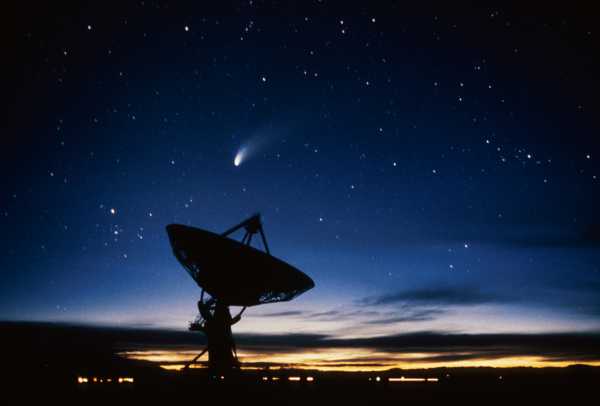
This story is part of a group of stories called

Finding the best ways to do good.
Fast radio bursts are one of astronomy’s tantalizing unsolved mysteries. These sudden pulses of radio waves come from far outside our galaxy. They last about a millisecond. And sometimes, the signals repeat.
Until recently, that’s about all scientists could tell you about fast radio bursts, or FRBs. Our radio telescopes, which pick up noise rather than light, first detected them in 2007; since then, we’ve recorded a few dozen more, but not enough to be able to put together a compelling theory of what causes them.
With the origin of these signals still unknown, some scientists — notably the chair of the Harvard astronomy department, Avi Loeb — speculate aliens could be sending them.
Now, researchers based in Canada, where a radio telescope exceptionally well equipped to detect FRBs began operating in 2018, have added a new piece to the puzzle. A few previously detected FRBs had been shown to repeat sporadically, without any regular pattern. But by observing the sky from September 2018 through October 2019, the researchers in Canada found 28 bursts — including one that repeats with a very regular pattern indeed: It appears every 16.35 days, to be exact.
This is the first time scientists have detected such a pattern in an FRB source. The peculiar signal is coming from a massive spiral galaxy 500 million light-years away. The source sends out one or two bursts of radio waves every hour, over four days. Then it goes quiet for 12 days. Then the whole process repeats.
So why is a radio signal repeating every 16 days like clockwork, and what can that teach us about its origins?
That’s the central question of a new paper authored by the Canadian Hydrogen Intensity Mapping Experiment in collaboration with the Fast Radio Burst Project (CHIME/FRB).
There are a couple of things we know for sure. The 16-day “periodicity” cannot be occurring “by chance coincidence,” the scientists write, and it’s “an important clue to the nature of the object.” It’s clear that the FRB can’t be originating from a cataclysmic event, like a star going supernova, since that’s a one-time affair.
But beyond that, the scientists really aren’t sure. They propose a few possibilities.
One explanation is orbital motion. Celestial bodies are known to orbit on regular timescales, so a pair of objects — like a star and a black hole — could account for the 16-day pattern. “Given the source’s location in the outskirts of a massive spiral galaxy,” the paper says, “a supermassive black hole companion seems unlikely, although lower-mass black holes are viable.”
The authors say FRBs could be generated if giant radio pulses from an energetic neutron star are eclipsed by a companion object. They also note that periodicity could arise from the rotation of a star, but that’s a tricky hypothesis: Previously observed sources have had way shorter periodicities (a few hours, not a couple of weeks) and way less strength (we’re talking nine orders of magnitude less) than FRBs have.
In short, the authors don’t know what’s causing FRBs. But aliens are not on their list of possibilities. They end their paper calling for more research.
Are aliens causing fast radio bursts? Probably not.
While grounded speculation among astrophysicists suggests that FRBs are caused by neutron stars, stars merging, or black holes, it’s a different theory that has caught hold of the public imagination: Maybe they’re caused by intelligent alien life.
A study by Avi Loeb and Manasvi Lingam of Harvard University, published in 2017, argued that the patterns could plausibly result from extraterrestrials’ transmitters. The paper is theoretical; it doesn’t propose any evidence for the “aliens” hypothesis, it just argues that it’d be compatible with the recorded data so far. They concluded it’d be physically possible to build such a transmitter — if you had a solar-powered, water-cooled device twice the size of Earth.
The hypothesis raises some obvious questions. FRBs come from all over space, not just from one particular region. Are we to assume that these aliens are sophisticated enough to have spread across many galaxies, but that there are no signs of them other than these energy bursts? Or that many civilizations independently settled on the same odd style of energy burst?
The 2017 paper argues for the latter possibility: that many civilizations have separately built such massive transmitters and are sending out FRBs. “The latest estimates suggest that there are ∼ 10^4 [10,000] FRBs per day,” the paper observes, which would suggest an implausible number of extremely busy, scattered alien civilizations. To resolve that, the paper argues that perhaps “not all FRBs have an artificial origin — only a fraction of them could correspond to alien activity.”
But once we concede that FRBs can occur naturally, and conclude that at least some of them are occurring naturally, why conclude that any of them are artificial?
And if a civilization had the astounding technical capacities to build solar-powered, planet-size transmitters, wouldn’t it be doing other things we could detect that would be less ambiguous?
“The possibility that FRBs are produced by extragalactic civilizations is more speculative than an astrophysical origin,” the paper concedes.
Indeed, that’s what the CHIME/FRB researchers behind the new paper think. “We conclude that the periodicity [of the FRB] is significant and astrophysical in origin.”
The broader debate over alien life
Scientists disagree about how to interpret phenomena like FRBs in large part because they disagree about how plausible alien life is in the first place. In statistical terms, they have different priors, meaning that the background assumptions they are using to interpret the new evidence are different.
From one perspective, the universe is astonishingly large, full of habitable planets like Earth where life could evolve as it did here. Sometimes, that life would become intelligent. We’d expect such a universe to have lots of flourishing civilizations — as well as lots of extinct ones.
This is clearly the expectation that motivates Harvard’s Loeb. “As soon as we leave the solar system, I believe we will see a great deal of traffic out there,” he said in a 2019 interview with Haaretz. “Possibly we’ll get a message that says, ‘Welcome to the interstellar club.’ Or we’ll discover multiple dead civilizations — that is, we’ll find their remains.”
If you think that space is teeming with aliens, it’s not so much of a stretch to interpret astronomical phenomena as remnants of those aliens.
But if you’re looking at the same data with the expectation that we’re alone in the universe, you’re much likelier to conclude that there’s a natural explanation for FRBs.
It’s weird, given that the universe is so vast, that we seem to be alone in it. Physicist Enrico Fermi was the first to spell out this dilemma, and it’s named after him: the Fermi paradox. The paradox is that, under some reasonable assumptions about how often life originates and reaches technological sophistication, we should be able to detect signs of thousands or millions of other civilizations. And yet we haven’t. Recent investigations suggest that the paradox may have a mundane resolution — under more accurate assumptions about how life originates, we are very plausibly, alone.
The disagreement between researchers who think advanced civilizations must be extremely rare and those who think they’re common is a fairly substantive one. For one thing, if advanced civilizations are common, then why can’t we see them? We might be forced to conclude that they’re fairly short-lived. That’s Loeb’s take: “The technological window of opportunity might be very small,” he told Haaretz.
That take would have some consequences for us. If there’s some danger ahead that destroys every technological civilization that runs into it, we might expect that we’re living in a “vulnerable world” where future technological advances will destroy us, too.
In that way, disagreements over aliens have big implications. But that’s probably not the reason everyone cares about them. Offhand speculation about aliens tends to get vastly more coverage than anything else in astronomy. Whether we’re alone in the universe feels like a profoundly important question, for its implications for human civilization but also for its own sake. The lack of evidence suggesting phenomena like FRBs are alien in origin won’t be enough to stop people from wondering.
Sign up for the Future Perfect newsletter and we’ll send you a roundup of ideas and solutions for tackling the world’s biggest challenges — and how to get better at doing good.
vox-mark
Sign up for the
newsletter
Future Perfect
Email (required)
By signing up, you agree to our Privacy Notice and European users agree to the data transfer policy.
For more newsletters, check out our newsletters page.
Subscribe
Future Perfect is funded in part by individual contributions, grants, and sponsorships. Learn more here.
Sourse: vox.com






